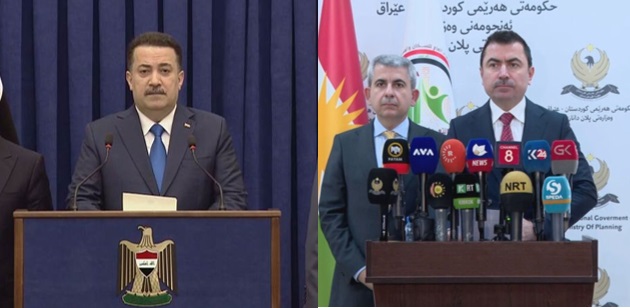Iraq’s population has surpassed 45 million, according to Prime Minister Mohammed Shia’ al-Sudani’s announcement on November 25, 2024, marking a major milestone in the country’s development. The results from Iraq’s first full census since 1987 offer key insights into the nation’s urban-rural balance, gender distribution, and the demographic make-up of the working-age population. Meanwhile, the Kurdistan Region also revealed its own population statistics, showing significant growth and a youthful population.
Population Growth and National Census Results
Iraq’s population has reached 45,407,895 people, according to the preliminary results of the national Population and Housing Census announced on November 25, 2024, by Prime Minister Mohammed Shia’ al-Sudani. This marks a significant step in updating the country’s population data after the census was postponed for decades. Sudani highlighted that 70.3% of Iraq’s population now lives in urban areas, with the remaining 29.7% residing in rural regions. The 2024 census is the first full census since 1987, following an incomplete one in 1997 that excluded the Kurdistan Region.
The census revealed that Iraq’s population is growing at a rate of 2.3%, with 7,898,588 families in the country and an average family size of 5.3 people. In terms of gender distribution, the census found that 50.1% of the population, or 22,784,062 individuals, are male, while 49.8%, or 22,623,833 individuals, are female. Notably, men head the majority of households in Iraq, accounting for 88.67% of families, while women represent 11.33% of household heads.
These statistics point to a shifting demographic with a youthful population, as 36.1% of Iraq’s population is under the age of 15, while 60.2% are of working age (15–64 years), with just 3.7% of Iraqis over the age of 65. This “demographic gift,” as described by Sudani, offers significant potential for economic growth, especially with a large proportion of the population entering or already in the workforce.
Kurdistan Region’s Population Breakdown
Parallel to the national census, the Kurdistan Regional Government (KRG) Planning Minister, Dr. Dara Rashid, provided the results of the census for the Kurdistan Region, revealing that its population now exceeds 6.3 million. The Kurdish region, which includes both locals and foreigners, has seen a steady increase in population, with 3,200,506 males and 3,170,162 females, accounting for 50.24% and 49.76%, respectively.
Rashid detailed that 84% of the Kurdistan Region’s population lives in urban areas, with the remaining 16% in rural areas. This is in line with trends observed across Iraq, with cities seeing larger populations due to ongoing urbanization. The region has 1,379,163 families, with an average household size of 4.6 members. The population growth rate in the Kurdistan Region is slightly higher than the national average, at 2.48%.
The working-age population in the Kurdistan Region is 63.7%, which is slightly above the national average, indicating a strong labor force. Additionally, 31.9% of the population in the region is under the age of 15, and 4.4% is over the age of 65. This demographic breakdown indicates that the Kurdistan Region has a similarly youthful population, which can potentially drive future economic growth.
Significance of the Census for Development and Planning
Prime Minister al-Sudani emphasized the importance of the national census as a tool for sustainable development and long-term planning. “This census is a crucial step towards shaping our development strategies and ensuring that we can meet the needs of Iraq’s diverse population,” he said. The census results will play a key role in shaping Iraq’s policies related to infrastructure, healthcare, education, and employment, providing a clearer picture of population trends across the country and in specific regions, including Kurdistan.
Al-Sudani also expressed gratitude for the cooperation of Iraq’s citizens during the census process, acknowledging the role of security forces, the United Nations Population Fund, and religious leaders in ensuring the success of the effort. Despite the challenges of conducting a nationwide census, especially in disputed areas, the results reflect a crucial step toward more accurate and up-to-date demographic data that will inform both national and regional development efforts.
Looking Ahead: Next Phases of the Census and Final Results
The census process is ongoing, with a second phase of data collection planned over the next two months. This will include a more detailed questionnaire covering health, education, housing conditions, and employment data, which will provide further insights into Iraq’s socio-economic landscape. The final results, which will include this additional data, are expected to be announced later in 2025.
Iraq’s most recent census in 1997 excluded the Kurdistan Region, making the current process particularly significant for the people of the region. The upcoming data will help address long-standing gaps in knowledge about the region’s population dynamics and will aid in crafting more tailored policies for the Kurdistan Region’s unique needs.
A New Era for Iraq’s Population Data
With Iraq’s population surpassing 45 million and the Kurdistan Region’s population exceeding 6.3 million, this marks a major step forward in the country’s demographic planning. The new census results provide not only a clearer understanding of the population’s gender, age, and urban-rural distribution but also insight into the growing workforce and family structures across Iraq and Kurdistan.
The success of this first comprehensive census in 37 years represents a new chapter for Iraq in terms of national development planning and governance. As the country moves into the next phases of data collection and analysis, these demographic insights will be instrumental in shaping policies that support economic development, social welfare, and sustainability for future generations. The updated population data will provide the government and international organizations with critical tools to address Iraq’s most pressing issues, from poverty reduction to employment creation and beyond.


